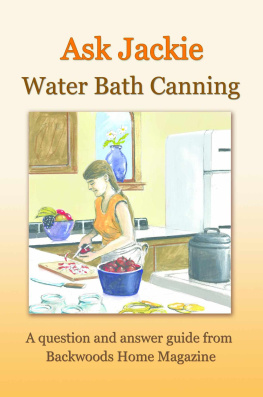Jackie Clay-Atkinson - Ask Jackie: Water Bath Canning
Here you can read online Jackie Clay-Atkinson - Ask Jackie: Water Bath Canning full text of the book (entire story) in english for free. Download pdf and epub, get meaning, cover and reviews about this ebook. year: 2012, publisher: Backwoods Home Magazine, genre: Home and family. Description of the work, (preface) as well as reviews are available. Best literature library LitArk.com created for fans of good reading and offers a wide selection of genres:
Romance novel
Science fiction
Adventure
Detective
Science
History
Home and family
Prose
Art
Politics
Computer
Non-fiction
Religion
Business
Children
Humor
Choose a favorite category and find really read worthwhile books. Enjoy immersion in the world of imagination, feel the emotions of the characters or learn something new for yourself, make an fascinating discovery.
- Book:Ask Jackie: Water Bath Canning
- Author:
- Publisher:Backwoods Home Magazine
- Genre:
- Year:2012
- Rating:4 / 5
- Favourites:Add to favourites
- Your mark:
- 80
- 1
- 2
- 3
- 4
- 5
Ask Jackie: Water Bath Canning: summary, description and annotation
We offer to read an annotation, description, summary or preface (depends on what the author of the book "Ask Jackie: Water Bath Canning" wrote himself). If you haven't found the necessary information about the book — write in the comments, we will try to find it.
Jackie Clay-Atkinson: author's other books
Who wrote Ask Jackie: Water Bath Canning? Find out the surname, the name of the author of the book and a list of all author's works by series.
Ask Jackie: Water Bath Canning — read online for free the complete book (whole text) full work
Below is the text of the book, divided by pages. System saving the place of the last page read, allows you to conveniently read the book "Ask Jackie: Water Bath Canning" online for free, without having to search again every time where you left off. Put a bookmark, and you can go to the page where you finished reading at any time.
Font size:
Interval:
Bookmark:
Table of Contents
Ask Jackie
Water Bath Canning
Copyright 1999-2012
ISBN: 978-0-9860152-7-4
Backwoods Home Magazine
PO Box 712
Gold Beach, Oregon 97444
www.backwoodshome.com

Edited by Jessie Denning, Julia Denning, Haley Kessel, Connie Sayler, Lisa Nourse, Rhoda Denning, and Ilene Duffy
Cover art by Don Childers
Illustrations by Don Childers, Jessie Denning, and John Dean
Introduction
Water bath canning, or boiling water bath canning as its often called, is the most simple method of canning. Its basically placing your filled jars of food into very hot water, covering the jars, and processing the jars for a certain length of time. Its quick and easy, but it is limited. Water bath canning should only be used to can fruits, jams, jellies, preserves, and pickles, as they are high-acid foods. Bacteria that could damage these foods are killed at boiling water temperature.
Unfortunately, low-acid foods such as vegetables, meats, and mixtures of the two, can contain bacteria and toxins that are not killed at boiling water temperature, no matter how long the jars of food are held in the boiling water bath canner. Therefore, these foods must be pressure canned.
Most of the questions in this book deal with some aspect of water bath canning, but there could be a couple that deal with pressure canning.
Water bath canning foods is a great starting point for beginners to learn to can a wide array of tasty foods, eventually building up their confidence and desire to go on to pressure canning.
In this book I answer questions on all aspects of water bath processing food, including: jams, jellies, preserves, fruit, and pickles. Have fun reading. I hope Ive answered many of your own questions along the way.
Jackie Clay
Jellies

Sealing jars
I just recently took an interest in making jellies, jams, and chutneys. I primarily do this around the holiday season for gifts. However, after reading your article on canning, I am concerned that I am not doing this right. I was told by my mother that all I would need to do is to sterilize the jars and then put my hot mixture into the jars and let them seal, so this is what I have been doing, and they have been sealing. She never indicated to me that I should then put the filled jars back in for more processing time.
Can you tell me how long the jams, etc. will be good for by the process I have been doing? I have made many jars already and hope that I can still use these for the holidays at least. My mom swears that they will keep for years with this process, also. I would appreciate it if you could please shed some light on this.
Jolee
Bottom line: always listen to your mother. Seriously, she is right. However, as some people in the past have put up big batches of jams, jellies, preserves, etc., and the batch has cooled down some while the entire batch was put into jars, the result was that some jars did not seal properly. Some jars molded and fermented so canning companies and home economists now often recommend processing smaller batches and processing many recipes with a water bath canner for a short time. This ensures the jars seal well and that the food remains hot enough to kill any molds and bacteria that could damage the food in storage.
Follow your recipe and if you are happy with it, keep up the good work. Some of my recipes require only filling hot, sterilized jars with a high-acid food (jam, pickle, jelly, etc.) and sealing with a hot lid and ring. Others advise a hot water bath processing time (often only five or ten minutes) to ensure sealing. I follow the recipe. Its usually when you improvise by doubling a recipe or otherwise altering it that you find yourself in trouble.
I have unprocessed jars of relish, jelly, etc. that are 10 or more years old, and still of excellent quality.
Putting wax on jelly
Hello. Its my first time ever making jam and I used metal-sealed lids and did the hot water bath. But, everyone told me maybe I should put wax just in case, so I put wax on the hot jelly and sealed it. Then I put it in the hot water bath. Is that okay? Or will it all be ruined? One tipped over too, with the wax.
Natalie
You dont need to use wax when you can jelly with regular canning jars and two-piece lids, using the hot water bath. I think your jelly will be alright. When wax is poured on top of hot jelly, it settles to the top and hardens. Ive used it in past times, when it was common practice to use odd jars as jelly jars and top the jelly off with wax. Unfortunately, several times mice would nibble through the wax to get at the jelly. This was not pleasant. So I began saving the odd jar lids to cap the wax-covered jelly. This was a pain, as you cannot imagine how many different lids and screw rings there are on these jars.
Now I simply use common pint and half-pint canning jars and process the filled jars in a hot water bath to ensure sealing. Simple, quick, and painless.
When you grow a good crop, put up all you can
I would like to know how long my home canned beach plum jelly can safely be kept on the shelf?
Pam Hall
How about forever? Honestly, Pam, most all home canned food, especially jams and jellies, can remain wholesome and great tasting for years and years on your pantry shelves. This is the reason that when I have a bounty of a certain food, I can all I can possibly put up, because in some years some things just dont make a crop. This allows you to build up a solid storage pantry. Some folks tell me, Oh, I only canned 20 pints of green beans and gave away the rest. We only eat a few jars every year, anyway. Phooey! Maybe next year the beans will freeze, be eaten by pests, or whatever. When I have the opportunity, I put up all I can.
Pectin
What is apple pectin? I know it is used in canning but how does it work? Under what circumstances and with what foods is it necessary in canning? I have also heard it can be helpful with arthritis/joint health and maintaining colon health. Are there other uses for it?
How does one obtain apple pectin from apples if there is no store? In other words, how did our great-grandmothers obtain, store, and use it? Can you get pectin from other fruits than apples? I think I have heard that grapes might have it is that correct? I seem to recall my mom saying that she didnt need to add pectin to her grape jelly because it already had it.
E. R.
Pectin is a naturally occurring substance found in many fruits that causes jelly and jam to jell. We often use it because if you do not use it in jams or jellies made from lower pectin fruits, you must mix the juice/pure and sugar, then slowly boil down the jam/jelly until the jelling point is reached; the product will solidify into jelly or jam and not remain a syrup. The only things you use pectin for in most canning is in jams and jelly. Preserves have enough fruit and sugar to set up without pectin added. The reason most modern home canners use pectin in their jams and jellies is that from a smaller amount of juice/pure, mixed with sugar, youll end up with more end product than if you just boil the sugar and juice/pure down until it jells.
To obtain apple pectin from apples, simply boil the skins and apple cores and even small immature green apples, sliced into thin slices. To a pound of this, add 1 pint of water. Simmer for 15 minutes. Use cheesecloth to strain off the juice. You may return the pulp to the kettle and again add a pint of water and simmer for another 15 minutes. Let this stand 10 minutes, then strain off the juice; do not squeeze the cheesecloth bag. Four cups of homemade pectin is used in place of bottle of liquid pectin in most recipes.
Next pageFont size:
Interval:
Bookmark:
Similar books «Ask Jackie: Water Bath Canning»
Look at similar books to Ask Jackie: Water Bath Canning. We have selected literature similar in name and meaning in the hope of providing readers with more options to find new, interesting, not yet read works.
Discussion, reviews of the book Ask Jackie: Water Bath Canning and just readers' own opinions. Leave your comments, write what you think about the work, its meaning or the main characters. Specify what exactly you liked and what you didn't like, and why you think so.













